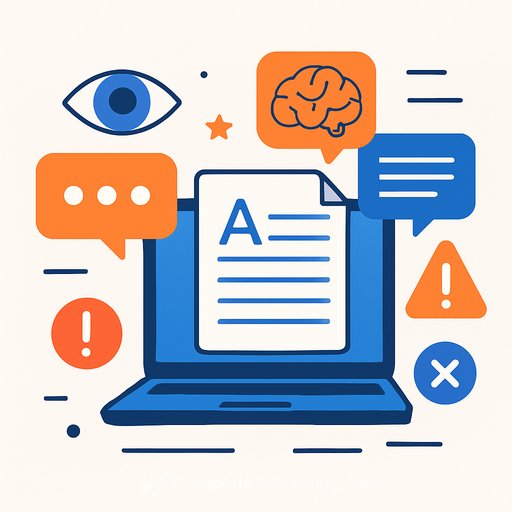AI Synthetic Reality: What It Means for Journalism (and Writers)
AI can now report, write, and present the news. That brings speed and scale-but also risk and accountability questions. As a writer, you need a clear way to use these tools without losing voice, ethics, or trust.
Highlights
- AI generates news scripts, drafts articles, and automates newsroom tasks.
- Benefits: speed, scalability, lower cost, consistent formatting, multilingual output.
- Risks: misinformation, weaker editorial judgment, legal exposure, and lower audience trust if misused.
What Is "Synthetic News"?
"Synthetic news" is any news content where reporting, writing, or presenting is produced or mediated by AI. It's not science fiction; it's a production choice.
- Synthetic anchors: AI avatars that read scripts with lifelike expressions and voice.
- AI-written articles: LLMs draft short updates, data summaries, and full stories.
- Newsroom automation: content selection, translation, headline testing, summarization, A/V production, and fact checks.
Examples in Action
Hangzhou News in China uses multiple AI anchors that mimic human delivery. Hour One converts a script into an on-camera "presenter" video in minutes. In Italy, Il Foglio published a clearly labeled AI-written supplement to test how audiences perceive voice and credibility.
Why Newsrooms Are Testing These Tools
- Cost and speed: AI handles earnings reports, sports recaps, weather, and routine briefs so humans can focus on analysis and investigation.
- Scale: One script can become many languages and formats, distributed across print, web, and social with minimal friction.
- Consistency and access: Clear formatting, fewer typos, and service to small or remote markets with limited staff.
Challenges and Risks
- Authenticity and trust: Lifelike anchors can mislead if not labeled. Deepfakes and propaganda are real threats.
- Weak context and ethics: AI lacks lived experience and may miss nuance or amplify bias from training data.
- Errors and hallucinations: Wrong facts slip in. Human verification is non-negotiable.
- Job displacement: Roles shift; some tasks shrink while editorial oversight and high-skill analysis grow.
- Legal exposure: Defamation, copyright, likeness/voice cloning, and unclear liability demand policy and contracts.
What the Research Says
Open models offer more transparency and auditability; closed models often ship cleaner outputs but with less oversight. Labeling matters: audiences notice differences in tone and credibility, even when content is clearly marked as AI-generated. Policies and clear disclosures help maintain trust.
What's Next: Trends for Writers
- Hybrid newsrooms: AI drafts; editors verify, add depth, and set standards.
- More realistic presenters: Better expressions, voice modulation, and synchronized gestures.
- Live AI summaries: Sensors, cameras, and feeds turned into instant briefs-then verified by humans.
- Clear policies: Labels for AI-assisted content, audit trails, and accuracy benchmarks.
- Personalization: Localization by dialect, format, and tone-without losing editorial integrity.
A Practical Workflow Writers Can Use Today
- Define the brief: angle, audience, claims to verify, sources to consult, and must-include context.
- Source before draft: gather datasets, transcripts, filings, and URLs; store citations next to notes.
- Draft with constraints: instruct the model on voice, structure, and length; require inline citations.
- Verify line by line: check names, dates, numbers, quotes, and links against primary sources.
- Bias pass: look for missing stakeholders, loaded language, and framing issues.
- Human rewrite: add context, nuance, accountability, and narrative flow. Keep your voice.
- Disclosure: label AI assistance where relevant; note what was automated.
- Retention and audits: keep a prompt log, model version, sources, and edits for accountability.
Checklist: Guardrails That Protect Your Byline
- Use model + retrieval for facts; never let the model "guess."
- Prohibit AI from inventing sources, quotes, or images.
- Store every source link and capture screenshots of key evidence.
- Set a hard rule: no publish without human sign-off.
- Label synthetic visuals and voices. Make the label obvious.
- Secure rights for any cloned voice or likeness in writing.
Tools and Learning
Test multiple models for specific tasks: summaries, translation, headline testing, and fact-checking prompts. Keep a style guide prompt and a stable source pack for each beat to reduce drift.
If you want structured training on AI for writing and editorial workflows, explore curated courses and tool lists here: AI courses by job and AI tools for copywriting.
Conclusion
Synthetic reality is changing how news is produced and presented. Writers who pair automation with strong editorial judgment will win on speed and trust. Keep the human voice, verify the facts, disclose the assist, and let your reporting carry the weight.
Your membership also unlocks:





